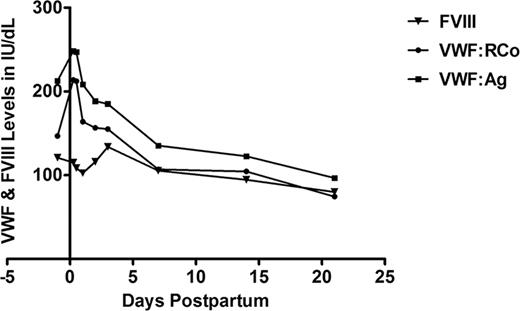Abstract
Abstract 2286
Von Willebrand factor (VWF) and factor VIII (FVIII) levels increase during pregnancy and return to baseline by one month postpartum (PP). Understanding the normal levels during this period has implications for the management of women with bleeding disorders. As part of a larger study of von Willebrand disease (VWD) postpartum, we obtained VWF ristocetin cofactor (VWF:RCo), VWF antigen (VWF:Ag) and FVIII levels on 26 women without a known bleeding disorder to establish normal ranges during the PP period.
Subjects were enrolled during the last trimester of pregnancy from obstetric clinics and physician practices affiliated with 4 university medical centers. VWF:RCo, VWF:Ag, and FVIII were obtained at enrollment, on admission to the hospital for childbirth, and at 4 hrs, 12 hrs, 24 hrs, 48 hrs, 72 hrs, and at 7, 14, 21, 28, and 42 days PP (6 weeks PP). Specimens were processed within an hour of venipuncture and centrally analyzed at the Duke Clinical Coagulation Laboratory. Means, standard deviations and 95% confidence intervals (CI) were established for each assay at each time point.
In the third trimester, mean VWF levels (VWF:RCo = 134 IU/dL [95% CI 113, 154]; VWF:Ag = 182 IU/dL [156, 209]) were 60–80% higher than the baseline levels at 6 weeks PP (VWF:RCo = 85 IU/dL [65, 105]; VWF:Ag = 103 IU/dL [87, 119]). On admission for childbirth, mean VWF levels were another 10–20% higher than the third trimester values (VWF:RCo = 147 IU/dL [108, 186]; VWF:Ag = 213 IU/dL [171, 255]). VWF levels peaked at 12 hrs PP (VWF:RCo = 214 IU/dL [171, 256]; VWF:Ag = 248 IU/dL [204, 293]) which was 140–160% above baseline (6 weeks PP). VWF levels gradually declined to 10% below baseline (VWF:RCo = 74 IU/dL [56, 93]; VWF:Ag = 97 IU/dL [80, 114]) at 3 weeks PP before returning to baseline at 6 weeks PP. This is in contrast to FVIII levels. In the third trimester, mean FVIII levels (FVIII = 127 IU/dL [111, 143]) were 40–50% higher than baseline (FVIII = 86 IU/dL [75, 97]), but on admission for childbirth, FVIII levels were 5% lower (FVIII = 121IU/dL [94, 148]) than the third trimester values. By 24 hrs PP, FVIII levels had dropped another 15% (FVIII = 103 IU/dL [91, 114]) before rising 30% to 134 IU/dL (101, 167). They gradually declined to 10% below baseline at 3 weeks PP (FVIII = 80 IU/dL [69, 91]; see figure) before returning to baseline at 6 weeks PP. These patterns were consistent despite age, race/ethnicity, parity or mode of delivery, although in women who underwent cesarean delivery, the initial nadir in FVIII levels occurred sooner than in women with vaginal delivery (4–12 hrs PP as opposed to 24 hours) and the subsequent peak in levels occurred sooner than in women with vaginal delivery (2 days as opposed to 3 days PP).
Unlike VWF levels which increase after delivery, FVIII levels drop 15% after delivery before rising again over the next 1–2 days, and then decline gradually. The explanation for this drop in FVIII is not, clear, but may be due to altered clearance or consumption of FVIII at delivery.
James:CSL Behring: Membership on an entity's Board of Directors or advisory committees, Research Funding. Kouides:CSL Behring: Membership on an entity's Board of Directors or advisory committees, Research Funding. Konkle:CSL Behring: Membership on an entity's Board of Directors or advisory committees. Philipp:CSL Behring: Membership on an entity's Board of Directors or advisory committees, Research Funding.


This feature is available to Subscribers Only
Sign In or Create an Account Close Modal